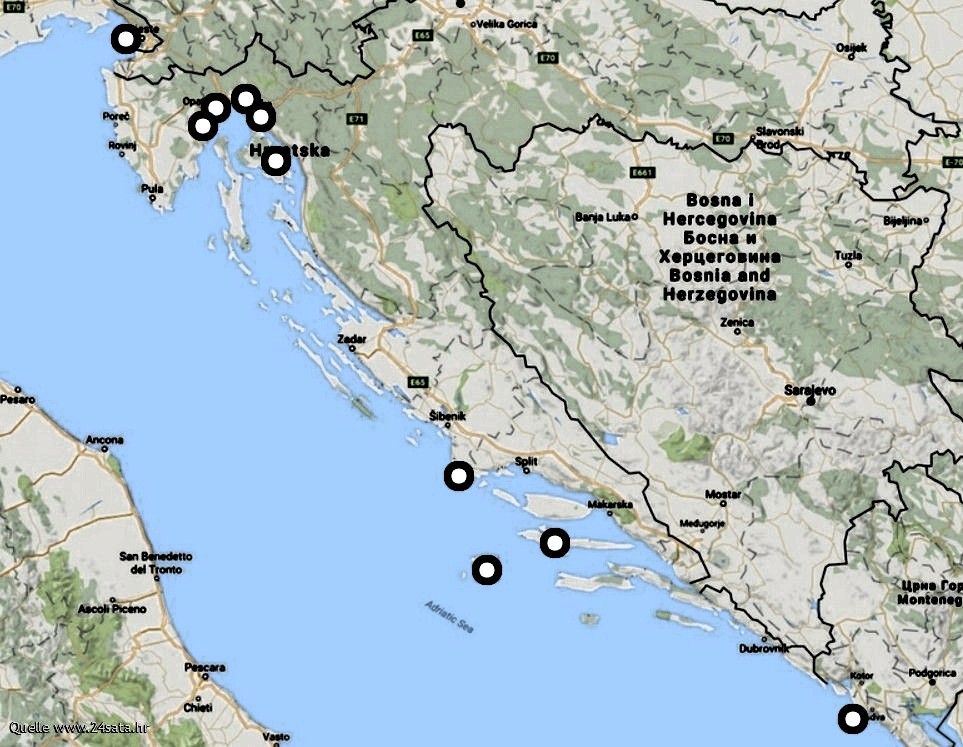Shark attacks in Croatia are very rare, but they do occur. The Adriatic Sea, where Croatia is located, is home to several species of shark. However, the majority of these species are not considered to be dangerous to humans and the last recorded attack took place in 2008.
11 Deadly Shark Attacks Recorded
There are over 30 species of sharks in the Adriatic. These include basking shark (Cetorhinus maximus), great white shark (Carcharodon carcharias), shortfin mako shark (Isurus oxyrinchus), blue shark (Prionace glauca), common smoothhead shark (Mustelus mustelus), porbeagle shark (Lamna nasus). The majority of these species in the Adriatic are not considered to be dangerous to humans.
Official data on shark attacks in Croatia (the Adriatic Sea) have been collected since 1868, for now over 150 years. Today, the statistics are kept by the US Shark Research Institute from Princeton, New Jersey, an organization dedicated to research and the protection of sharks. Since 1868 there have been 11 recorded deadly attacks in the Adriatic.
In 1868 a swimmer died off Trieste as a result of an attack. In 1907, it caught swimmers near the Croatian islands of Krk and Hvar. In 1934 a fatal attack on a Slovenian tourist happened near Kraljevica in the Kvarner Bay. In the summer of 1955 there was an attack at Opatija (Kvarner Bay) and at Budva in Montenegro.
Map of Fatal Shark Attacks in the Adriatic

In Opatija, the victim was a 32-year-old German tourist from Augsburg. Near Budva, a 6.5-meter-long great white shark is said to have bitten half through a student from Belgrade. In Opatija, in 1961, a student from Belgrade was hit by the shark, biting off both legs and part of an arm. The 19-year-old swam with friends about 100 meters from shore. In Kvarner Bay there was another fatal shark attack near Bakar in 1966, the victim was a Czech tourist. The Czech was swimming behind a tuna fisherman’s net when the shark attacked him.
The next victim was a Polish tourist near Ika in 1971. The last fatal attack was in 1974 near Omis in Dalmatia by 21-year-old German tourist Rolf Schneider. The last recorded shark attack in the Adriatic happened in 2008. A great white shark bit the lower leg of a diving instructor from the Slovenian army off the island of Vis.
Tourists are Most Likely Shark Attack Victims
It is striking that no shark victims came from Istria, the Kvarner region or from Dalmatia, the whole coastal region of Croatia. This may suggest that tourists are taking a bigger risk and swimming further out. Also, there seems to have been fewer great white sharks in the Adriatic since the 1970s. This in turn will be related to the fact that there is less forage in the Adriatic due to the overfishing of tuna.
In Croatia, the rule still applies that you are more likely to die driving to the beach than by encountering a shark. However, one should not underestimate the danger. “Climate change has had a negative impact on marine organisms. Although this is an increase of about one degree Celsius, the consequences are devastating,” says Zagreb marine biologist Peter Kružić. According to the expert, there could be a change in biodiversity among sharks, which would then exhibit more aggressive behavior.
Kružić advises that if you encounter a shark, flee as quickly as possible without creating too much of a fuss. “Of course, one should also hope that the shark isn’t hungry or curious. This is often not the case in the Adriatic,” says Kružić in an interview with kosmo.at.
Records of sightings or encounters with great white sharks in the Adriatic Sea have been collected since the Middle Ages. A total of 628 cases were documented between the years 467 and 2015. The great white shark has been present almost everywhere in the Mediterranean since living memory.
Very Low Risk of Shark Attacks
Nobody knows how many great white sharks live in the Mediterranean, explains Gabriel Morey (marine biologist) for standard.at. The only thing that is certain is that they are extremely rare. There may only be a few hundred sexually mature specimens. There is hardly any threat from the big fish themselves. Although there have been isolated attacks on people on European coasts in the past, in view of the many millions of swimmers, the risk is apparently extremely low.
These cartilaginous fish are in bad shape throughout the Mediterranean, as the WWF writes in its 2019 shark report for the Mediterranean (Sharks in Crisis – A call to action for the Mediterranean). Of the 73 species currently found there, more than half are endangered.
Sources: 24sata.hr, welt.de, focus.de, kosmo.at, krone.at, sharks.org, proplanta.de, wikipedia.de, derstandard.at, 100posto.hr, stiftung-meeresschutz.org